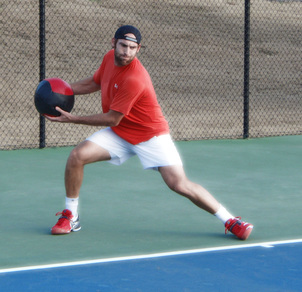Acceleration + Deceleration = Effective Tennis Specific Movement
Dynamic balance is paramount in tennis, specifically during the deceleration movement phase before the player makes contact with the ball. Dynamic balance is the ability of the athlete to maintain a controlled center of gravity while the athlete is moving. This efficient energy transfer from the ground up through the entire kinetic chain (from the ground all the way into the ball) will result into a more efficient and powerful tennis stroke - faster racket head speeds and ball velocities.
Eccentric Strength
Eccentric strength requires training of the muscles during the lengthening phase of the muscle action. Eccentric strengthening exercises need to be performed both on two feet as well as one foot. Nearly all tennis movements require the athlete to load one side of the body more than the other, and it is paramount that these uneven loading patterns are trained eccentrically as well as concentrically. Some great research performed by Dr. Todd Ellenbecker (chair of the certification commission of the International Tennis Performance Association) as well as other researchers have shown that physically trained humans can support approximately 30% more weight eccentrically than concentrically. Therefore, eccentric focused strength training needs to be incorporated into an athlete’s periodized program to successfully maximize their strength gains. A second major benefit of training eccentric strength is to aid in the prevention of injuries. A large portion of injuries to tennis players are due to insufficient eccentric strength in both the lower and upper body.
Power
Power for the tennis player is what directly translates into greater racket head speed and ball velocity. The power equation is (Force X Distance) / Time. In simple terms, a powerful athlete produces high forces, over the greatest distance, in the shortest period of time. The importance of power training for tennis is well understood by most coaches and trainers; however, power is typically trained with the major focus on the concentric phase of the muscle movements. Most medicine ball drills and plyometric movements focus on developing power. However, training focused on the landing aspect of the plyometric movements or the catching (instead of throwing) aspect of the medicine ball workouts are many times overlooked or not emphasized appropriately.
Reactive Strength
Reactive strength has been defined as the ability to quickly change during the muscle contraction sequence from the eccentric to the concentric phase in the stretch-shortening cycle (SSC), and is a specific form of muscle power. A plyometric training program which utilizes lateral and multidirectional movements while limiting time on the ground will develop reactive strength and subsequent power outputs in the muscles and movements that are seen during tennis play. This type of training directly relates to a tennis athlete in their recovery sequences between shots and also during the times in a point when they are “wrong-footed” and are in need of rapid change of direction.
Summary
Deceleration ability of a tennis athlete is closely linked to successful agility and multi-direction movements. As such, it needs to be trained in a multi-focused training program with appropriate rest periods and loads that are progressed based on the tennis player’s growth, maturation and training stages. From a training perspective the posterior muscles of the tennis athlete needs to be a focus if the athlete is to become a successful player who has great deceleration ability. Training athletes to accelerate and be fast is only half the equation; deceleration before (or immediately after) racket and ball contact is a major link in the chain for successful performance, and if the deceleration link is not trained optimally the athlete will never reach his or her full potential. It is highly encouraged that you work with a certified tennis performance specialist (CTPS) who has the required knowledge, skills and abilities to specifically train tennis athletes as training for deceleration is challenging due the higher forces (predominantly due to eccentric muscle actions) that are applied to the athlete to stop quickly.






 RSS Feed
RSS Feed
